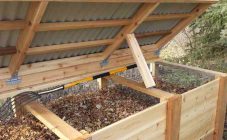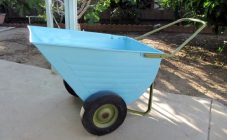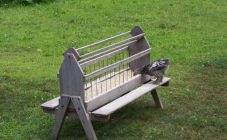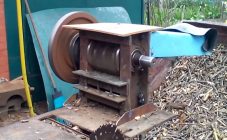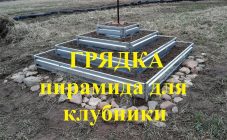Content:
The currant bush has a spreading shape. Its lower branches descend to the ground. As a result, the berries are on moist soil, which leads to their rotting. Experienced gardeners use bush stands to get rich harvest. There are several common ways to fence currants with your own hands.
The use of such specialized props in the country has a number of advantages:
- neat, decorative plant shape;
- increased productivity;
- improving the quality of berries (keeping them from dirt and mold);
- simplification of fruit collection;
- easier care for the shrub (it is easier to prune old shoots, weed and loosen the soil);
- additional protection from animals (birds and rodents);
- strengthening from rain and strong gusts of wind.
Supports are available at garden stores. However, you can fence the currants with your own hands.
Support from pegs and twine
The simplest version of the fence for currant bushes is made of pegs and twine. If the design is carried out in good faith, then it will stand for several seasons. This fence will require:
- 5 stakes of such length that they rise above the soil about 0.5 m (more stakes are used to support a powerful, spreading bush);
- twine (you can use wire or twine instead).
Stakes are set around the currants at such a distance so as not to damage the roots. Then the twine is fixed on one of the pegs. Picking up branches to the desired height, they fix it on the next support. Thus, they go around the whole bush, lifting the shoots and tying the twine to the stakes. It turns out an impromptu fence.
Fence made of spears and simple branches
Fencing for currants from spears and simple branches is one of the most budgetary structures. Roach can be made from unnecessary branches of a fruit tree on your site or found in the forest. If a suitable material has not been found, then you can make it yourself from the boards.
The opposite end of the spear should be sharpened to make it easier to stick it into the ground. If the fence does not hold well in the ground, then it can be secured with additional pegs. It is desirable that the branching angle of the spear is wide enough. Then the branch, which will be attached from above, can lie tightly at its base.
Four spears are installed around the bush at the desired height. On top of the fork, dry, strong branches are superimposed. Then they should be tied up with a rope or wire.
Iron-based hedge holders
The metal fencing is durable and has a long service life. To create it, you need scraps of metal pipes, wooden slats or bars.
Pipe supports are installed around the bush. Small wooden rods are fixed in their holes. You can use unnecessary sticks. Flat boards and slats are laid on top of them, which are then fixed with self-tapping screws.
Instead of bars, slats and planks, you can fence off with metal wire. To do this, measure the gap between the iron supports. Another 20 cm is added to a wire of this length. The ends of the obtained segment are bent 10 cm on each side and inserted into the holes of the pipes. A wire fence should be wrapped in soft rubber so as not to injure the branches.
Also used protective rings made of iron, bolted together. These hoops are fixed to the supports with hooks. The rings are put on in the spring on the bushes from above until the leaves appear.
To give a decorative look, the bush holder can be painted. It is recommended to use paint to protect the metal from rust.
Bush holders made of plastic pipes
Plastic currant fences look decorative. In terms of strength, they are comparable to metal structures. To create them, you will need PVC pipes 4 meters long and 4 corners for connecting the pipes.
The assembly of the currant fence begins with cutting the pipes into 8 equal parts. If the bush is tall, then pipes are taken longer so that the structure is higher. You can cut it with a hacksaw for metal or a pipe cutter. 4 plastic supports are placed around the bush. They are connected to each other using the rest of the plastic pieces and "triangles", fixing them with screws or an iron for soldering the propylene pipes.
Gardeners who are interested in how to properly enclose a currant bush can use fiberglass composite reinforcement with a diameter of 4 mm or a single-core stranded wire in single insulation about 5 m long. They are pulled through the holes in the supports.
Plastic pipe bush holder - lightweight construction. For better balance, you should stick it deeper into the ground.
Bush holder made of metal-plastic pipes
The metal-plastic support is one of the most durable and decorative.
1 way
To make a currant fence with your own hands, you need the following materials:
- metal-plastic pipe;
- nails or screws;
- a piece of rubber hose;
- pieces of wood;
- hand saw;
- hammer;
- screwdriver.
First, supports are made from the pipe, cutting off 3 equal parts of about 80 cm from it. For greater stability of the fence, you can build a larger number of stakes.
Then, two identical hoops are made from the remaining pipe. To connect the pipes, hose segments 10-20 cm long are used. The diameter of the hose must be carefully selected so that the metal-plastic does not dangle and fit snugly.
Wood is hammered into the openings of the supports. The top hoop is attached to these wooden pegs using nails or screws. The lower circle is fixed to the supports through pipes or simply slips onto the lower part using a wire for fastening. After installing the bush holder, the lower hoop should be located at a height of 20-30 cm from the ground surface.
To make the design less conspicuous and in harmony with the bush, it is recommended to use green materials.
2 way
Before you independently make such a fence for currants, you need to prepare the following materials:
- metal-plastic pipe;
- polypropylene pipe;
- "Tees";
- apparatus for welding plastic pipes (soldering iron);
- a piece of hose.
A hoop is constructed from metal-plastic. 3-5 supports are made of polypropylene. Then "tees" are soldered to the supports. Tees are placed on the hoop and spread evenly. The ends of the hoop are fixed with a piece of hose. The posts can be installed on metal pegs driven into the ground. Then the structure will be the most stable.
Wooden fencing
You can fence a currant bush in the country with the help of wooden slats. A bush holder made of natural materials will not only serve as a support for the currants, but will also harmonize well with the local landscape.
To make this fence you will need:
- 4 pegs 70 cm long;
- narrow strips for a garden fence (they can be cut from a bar) measuring 100 cm in length;
- hammer;
- self-tapping screws;
- screwdriver.
Pegs are hammered around the bush. They can be pretreated with a moisture and decay agent.
Check that the supports are at the same height. Then, using self-tapping screws, the strips are fixed on the pegs. Wooden fencing can be painted green or some other bright color. Some summer residents prefer coating with yacht varnish, which not only protects against moisture, but also adds decorative effect to the products.
Each summer resident chooses which he wants to make a fence for currant bushes with his own hands. At the same time, it takes into account practicality, durability, the availability of scrap materials and ease of manufacture.
The cheapest options from the considered fences: from pegs and twine, from spears and branches. These holders are not as reliable in bad weather conditions, but reassembling them is not difficult. Moreover, they are easy to disassemble. This means they can be used for the next season.
A fence made of wooden slats, using self-tapping screws, is already more solid. He looks more presentable than the previous options. This is a non-separable design. The disadvantage is that if it is not removed for the winter, then with a lot of snow, it can break. And if you try to remove it in the fall, you can break the grown branches.
Bush holders made of plastic pipes are neat and reliable. Only such structures should be built from thick materials, otherwise in winter they can break under a layer of snow, and become fragile under the influence of low temperatures.
Fences made of metal-plastic pipes are considered the most durable, decorative and expensive. However, a gardener who has allowed himself such a luxury, such a fence for currants will delight for many years and justify the funds invested in it.
Specialized supports are important not only for currants, but also for growing ornamental and fruit and berry bushes. Such coasters are suitable for viburnum, gooseberry, raspberry, blackberry. Ornamental plants also need them: roses, hydrangeas, chubushnik.






